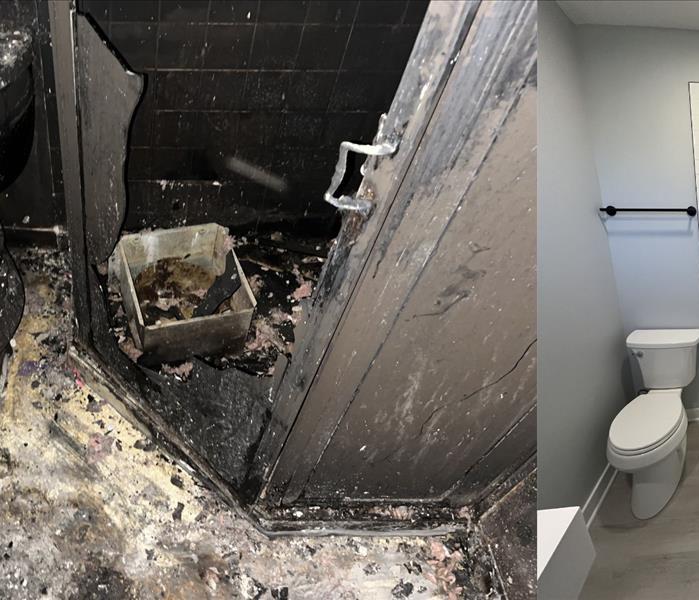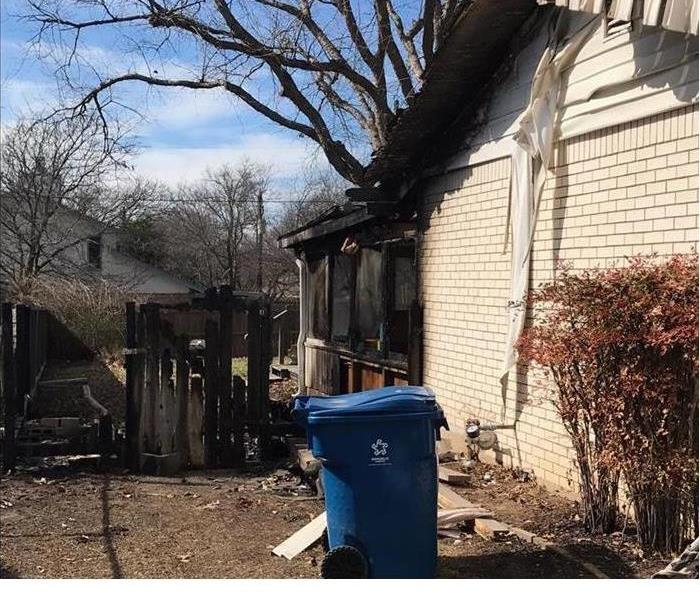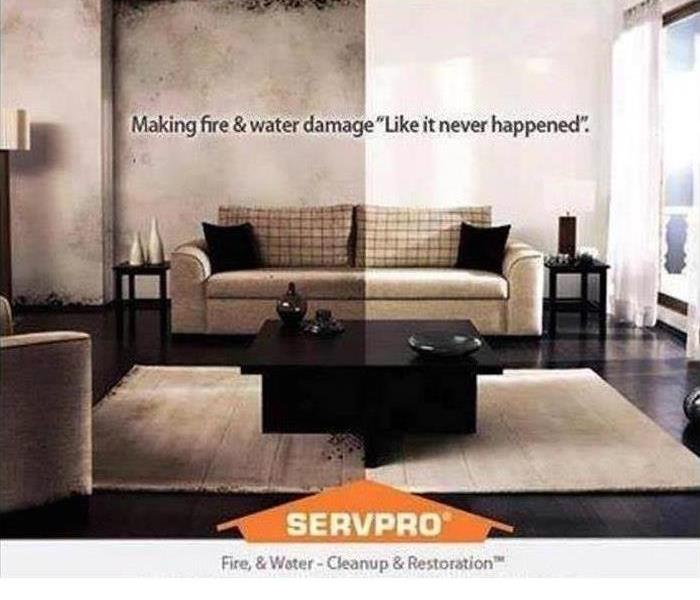Archived Fire Damage Blog Posts
How SERVPRO® Handles Fire Damage and Contents Cleaning
10/1/2024 (Permalink)
When a fire strikes, the damage goes beyond what meets the eye. Along with structural damage, personal belongings often suffer from smoke, soot, and water exposure. At SERVPRO®, we understand how overwhelming this can be, which is why we’re here to guide you through the recovery process every step of the way.
Specialized Fire Damage Restoration
Our experienced team is trained to handle every aspect of fire damage, from smoke and soot removal to odor neutralization and structural repairs. We use industry-leading equipment and techniques to restore your home or business to its pre-fire condition.
Contents Cleaning in Our Fire Warehouse
What sets us apart? SERVPRO has its very own fire warehouse dedicated to contents cleaning. Your belongings are carefully packed, transported, and stored in our secure facility. Using specialized cleaning methods, we restore items that may otherwise seem beyond repair—whether it’s furniture, clothing, electronics, or cherished keepsakes.
Let SERVPRO help you recover faster, with the care and expertise you can trust.
How SERVPRO® Handles Fire Damage and Contents Cleaning
10/1/2024 (Permalink)
When a fire strikes, the damage goes beyond what meets the eye. Along with structural damage, personal belongings often suffer from smoke, soot, and water exposure. At SERVPRO®, we understand how overwhelming this can be, which is why we’re here to guide you through the recovery process every step of the way.
Specialized Fire Damage Restoration
Our experienced team is trained to handle every aspect of fire damage, from smoke and soot removal to odor neutralization and structural repairs. We use industry-leading equipment and techniques to restore your home or business to its pre-fire condition.
Contents Cleaning in Our Fire Warehouse
What sets us apart? SERVPRO has its very own fire warehouse dedicated to contents cleaning. Your belongings are carefully packed, transported, and stored in our secure facility. Using specialized cleaning methods, we restore items that may otherwise seem beyond repair—whether it’s furniture, clothing, electronics, or cherished keepsakes.
Let SERVPRO help you recover faster, with the care and expertise you can trust.
Fire Pit Safety in Fairfield County, Ohio: Enjoying Cozy Evenings, Safely
10/30/2023 (Permalink)
Fairfield County, Ohio, with its picturesque towns like Lancaster, Pickerington, Carroll, Canal Winchester, Amanda, Millersport, Pleasantville, Bremen, Hideaway Hills, and Royalton, offers the perfect backdrop for cozy evenings around the fire pit. Whether it's a family gathering or a quiet night under the stars, these moments are cherished. However, safety should always be a priority when it comes to enjoying an open flame. Here are some essential fire pit safety tips to keep in mind:
- Location Matters
Choose a suitable location for your fire pit, ensuring it's well away from structures, overhanging trees, and any flammable materials. Consider local regulations and maintain a safe distance.
- Keep It Contained
Use a fire pit with proper containment like a sturdy metal or stone ring. This helps prevent embers and sparks from escaping and causing unintentional fires.
- Monitor Weather Conditions
Check the weather before lighting a fire. Wind can carry sparks and embers, increasing the risk of accidents. If it's windy, it might be best to postpone your fire pit gathering.
- Quality Fuel
Use only seasoned, dry wood for your fire. Green or wet wood can create excessive smoke and increase the risk of a fire getting out of control.
- Keep a Safe Zone
Establish a safe perimeter around the fire pit, and ensure children and pets understand the boundaries. Never leave the fire unattended, and always have a fire extinguisher or hose nearby.
- Extinguish Properly
When you're done enjoying the fire, extinguish it thoroughly using water. Stir the ashes and embers to make sure everything is out. Don't leave it smoldering.
- Be Mindful of Local Regulations
Each town or city in Fairfield County might have its own regulations regarding fire pit usage. It's essential to be aware of and comply with these rules.
Remember, fire pit safety is the key to enjoying the warmth and ambiance without the worry. Keep these tips in mind, and your evenings around the fire pit in Fairfield County, Ohio, will be filled with comfort, laughter, and peace of mind.
What You Need To Know About Fires!
12/6/2022 (Permalink)
Timing is everything. In just two minutes, a fire can become life-threatening. In five minutes, a residence can be engulfed in flames.
- Fire is FAST! In less than 30 seconds a small flame can turn into a serious fire. It only takes minutes for thick black smoke to fill a house or for it to be engulfed in flames - impairing vision and breathing.
- Fire is HOT! Room temperatures in a fire can be 100 degrees at floor level and rise to 600 degrees at eye level. Inhaling this super-hot air will scorch your lungs and melt clothes on your skin. Always crawl on the floor!
- Fire is DARK! Fires start bright but quickly produce black smoke and complete darkness.
- Smoke is DEADLY! Smoke and toxic gases kill more people than flames do. Fire produces poisonous gases that disorient you. Asphyxiation (suffocation) is the leading cause of death from home-related fires.
Since each smoke and fire damage situation is a bit different, each one requires a customized solution tailored to the specific conditions. Our SERVPRO Team has the necessary equipment, expertise, and experience to restore your fire or smoke-damaged property. Most importantly, we will also treat your family with empathy and respect and your property with care.
What To Expect After A Fire
3/17/2022 (Permalink)
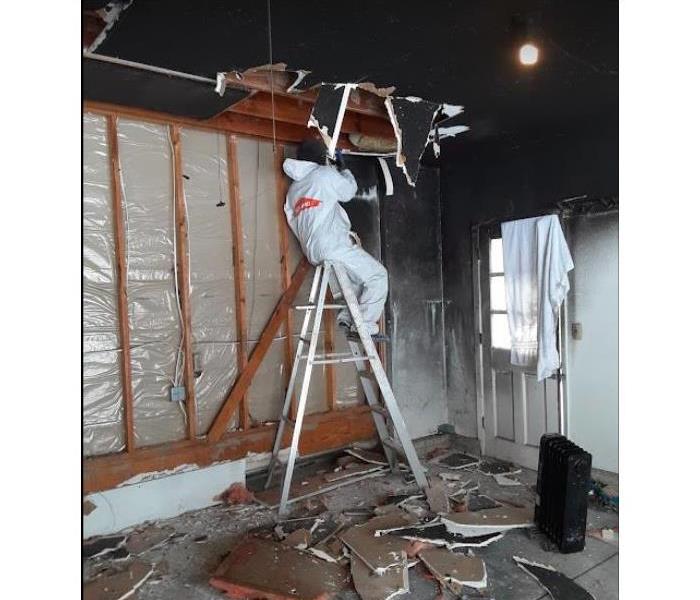 Our SERVPRO team is ready to restore your Columbus fire damaged property.
Our SERVPRO team is ready to restore your Columbus fire damaged property.
A fire damage event is difficult for the home or business owner on many levels, and the restoration process that follows can be intimidating. Each fire event is a little different, and each will require a unique solution, although the overall general process stays the same. The steps we are listing below will illustrate the SERVPRO process for the average fire damage emergency.
- Emergency Contact. Your restoration process begins the moment that you contact us. Our representative will ask you questions regarding the fire damage event that will help us to respond with the appropriate equipment and resources for your particular situation.
- Inspection and Fire Damage Assessment. Our team will carefully inspect and test all the adjoining rooms of your home or business to determine the extent of the fire, smoke, and soot damage. This step is vital to us, allowing us to develop the perfect plan of action for your property.
- Immediate Board-Up and Roof-Tarp Service. Fire damage will often compromise the condition of windows, walls, and roofing. To maintain security and to protect against further damage, we will board up missing windows and walls, and place tarps on damaged areas of the roof.
- Water Removal and Drying. If water damage is present, the water removal process will begin almost immediately, with the goal of removing the majority of the water. Our team will then employ dehumidifiers and air movers to remove any remaining water and complete the drying process.
- Removal of Smoke and Soot From All Surfaces. SERVPRO uses specialized equipment and techniques to remove smoke and soot from ceilings, walls, and all other surfaces.
- Cleaning and Sanitizing. We clean, sanitize, and disinfect all of the restorable items and structures that were damaged by the fire. Our team uses a variety of cleaning techniques to restore your belongings to the condition they were in before the fire. We are also trained to remove lingering odors, using industrial air scrubbers and fogging equipment.
- Restoration. This is the final step - getting your home or business back to its pre-fire condition. Restoration may involve minor repairs, such as replacing drywall, installing new carpet, or painting surfaces, or it may entail major repairs, such as the reconstruction of various rooms or areas.
Here at SERVPRO of Fairfield County we are here to help if your home or business suffers from damage due to a fire.
What Are Soot Tags?
3/9/2022 (Permalink)
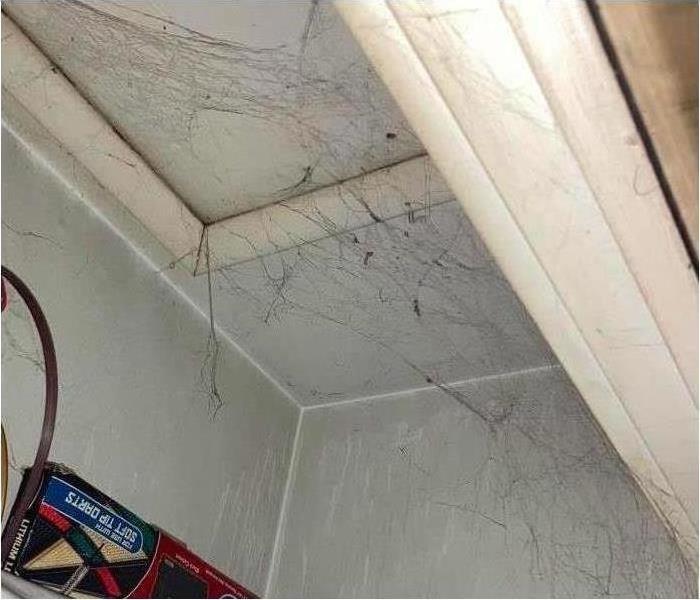 Here is an example of soot tags. You can see how closely they resemble spider webs.
Here is an example of soot tags. You can see how closely they resemble spider webs.
As fire damage specialists, we see a lot of fire damaged residential homes and commercial properties. The damage can either be extensive or very minimal. One of the most common visible instances of fire damage are soot webs, the technical term for them are "Soot Tags". They look exactly like spider webs. Rest assured, you did not have magical "fire spiders" that created these cobwebs in your home.
Soot Tags form in areas of low circulation when petroleum/synthetic based sources burn. During a fire the heat of the fire moves into colder areas since the air seeks to create equilibrium. The soot then rides in the air with the heat particles that follow the air into those colder areas with low circulation and are able to concentrate. Since that soot is a product of combustion the particles themselves are charged which makes it quite easy for them to create long chains of soot or soot tags. So while it looks like a lot of soot got stuck on pre-existing spider webs it is actually a whole new structure.
If you notice that you have soot tags in your home or business after a recent fire, do not try to clean it up yourself. Any time you try to clean soot without the proper chemicals, tools and experience, you’ll likely cause further damage in your home. That's why our SERVPRO of Fairfield County Team is here to help, we are the fire damage restoration specialists at your service 24-7!
Reducing Your Risk Of a House Fire
3/4/2022 (Permalink)
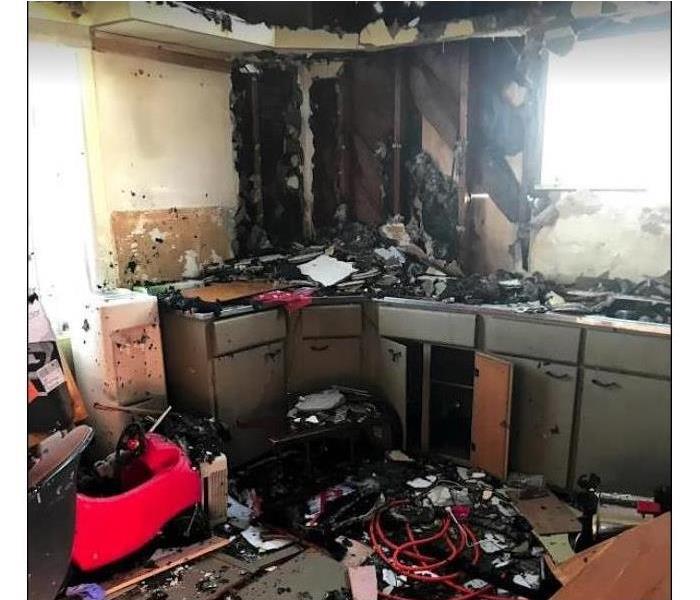 Call our SERVPRO of Fairfield County Team for all of your fire damage needs.
Call our SERVPRO of Fairfield County Team for all of your fire damage needs.
Your home is your sanctuary. A place where your family spends time together and makes memories. That’s why it is so scary imagining your home getting damaged by an unfortunate fire. Although you can’t control everything that happens in your home, there are some necessary tips you can follow to prevent a possible house fire. Follow these tips below.
- Regularly test your smoke alarms. Test your smoke alarms by pressing the button located on the smoke alarm, if it produces a weak beeping noise, it is time to replace the batteries.
- Check your heating sources. Heating sources that aren’t working properly could potentially trigger a fire. Have them checked annually.
- Maintain a clean oven and stove. Food particles left behind can get to hot on the burner or in the oven causing a potential fire. Make sure nothing is left too close to the stove that could catch fire.
- Never leave your kitchen. Don’t leave your kitchen while cooking. It only takes a few seconds for a fire to break out. If you have to step out of the room, turn the burners off.
- Check your dryer. Make sure to clean out your lint trap after every load of laundry. The build up of lint can cause a fire. Have your dryer inspected by a professional yearly.
- Inspect your cords. Before plugging something in, inspect the cord to make sure it is not frayed or been chewed. Replace the cords as soon as possible if you notice that the wires have been damaged. Avoid running cords under a rug or between the wall and your furniture, it can get too hot causing a fire.
- Store flammable products properly. Store common household cleaners and cosmetic items in a cool area. If they are exposed to high heat, they can combust.
- Use caution with candles. Put candles out before you leave the room or go to sleep and make sure to keep them far away from blankets or any other objects that could catch fire. Place candles on an even surface to prevent them from being knocked over. Also keep them away from pets.
- Use caution with your fireplace. Make sure there is a door between the flames and your flooring, you don’t want any sparks to escape. Allow enough time for the ashes to cool down before throwing them away.
- Always have a fire extinguisher handy. When a fire breaks out, your best line of defense is a fire extinguisher. Make sure every family member knows how to use it properly in case of a fire.
Preventing Grease Fires
3/3/2022 (Permalink)
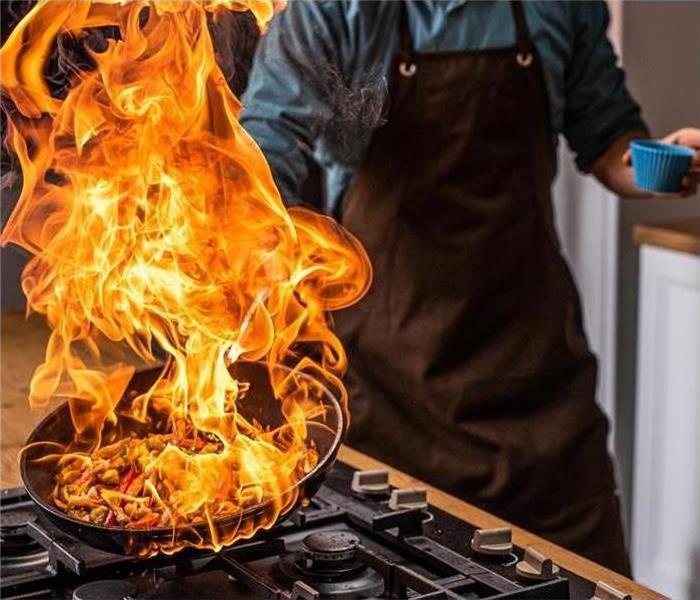 Don't let a grease fire destroy your home!
Don't let a grease fire destroy your home!
Whether you are cooking in a restaurant or in your own home, a grease fire can quickly become a big disaster. Grease fires can present themselves as a difficult issue since they are notorious for being difficult to put out.
The first reaction to a fire is to pour water on it, which for grease fires, can actually spread the fire and make it worse!! Follow the correct steps below on putting out a grease fire.
How do I put out a Grease Fire?
- Turn off the heat. Make sure to not pick up the pan. Picking up the pan can cause the fire to quickly spread to you or spill onto other surfaces in the kitchen.
- Put a lid on the pan to cut off oxygen to the fire. Once it has sufficiently cooled down, you will be to move and clean it.
- If the fire gets out of hand, make sure to call 911 to get assistance right away from the Columbus Fire Department.
- NEVER pour water on an active grease fire or fan the fire. Both of these actions will only spread the fire.
- Do NOT fan the fire with a dry or wet cloth, it can make it worse and spread the fire.
- If all else fails, use a fire extinguisher to put out the flame.
How to Prevent A Grease Fire
- Never leave your cooking unattended, always keep an eye on any pots or pans.
- Make sure that you have a sufficiently sized lid for all of your cooking ware.
- Heat the oils in your pans slowly, don't put your stove on the highest setting right off the bat.
- Turn the heat off if you think your pans are getting too hot.
Due to the nature of a grease fire, it is highly recommended that you seek out the help of a professional like SERVPRO of Fairfield County for fire restoration help. In addition to cleaning up any damage such as burned materials, soot, or grease, a professional can help your kitchen rid itself of the smoke scent.
Our SERVPRO of Fairfield County Team has the knowledge and decades of experience to help you quickly and effectively repair damage from a grease fire.
Specialized Fire Damage Services
2/24/2022 (Permalink)
 SERVPRO of Fairfield County boarded this home after a fire.
SERVPRO of Fairfield County boarded this home after a fire.
Along with providing structural cleaning, contents cleaning, and deodorization in the central Ohio area after a residential or commercial fire, SERVPRO of Fairfield County also offers additional specialized services to our customers:
Board-Up
One of the top priorities after a fire loss is to secure your property and belongings until work can begin. SERVPRO of Fairfield County offers board-up services for windows, doors, and other exposed structural areas to prevent intrusion by both water and unauthorized persons.
Inventory, Pack-Out and Storage
As the clean up and restoration process begins, our SERVPRO of Fairfield County technicians take inventory of the contents in your home or business. As the contents are sorted, they will be categorized as salvageable, and processed to be cleaned, or unsalvageable, and documented as such for insurance purposes. Our professional SERVPRO Team can pack-out and store any unaffected materials as needed as well. Our SERVPRO Professionals are trained to properly inventory, move out and control the contents from the structure during the cleaning, restoration, and deodorization process.
Document Drying and Restoration
The SERVPRO Document Restoration Team offers a range of services to restore your damaged documents, including drying, cleaning/disinfecting, re-jacketing, digitizing, and deodorization. Depending on your specific needs, and utilizing industry leading techniques and state-of-the-art technology, SERVPRO’s restoration professionals will help you recover paper goods, no matter the size of the loss.
SERVPRO of Fairfield County is Here to Help with all your fire damage needs. Our professional team will help make it “Like it never even happened.”
Stages of a Fire
2/23/2022 (Permalink)
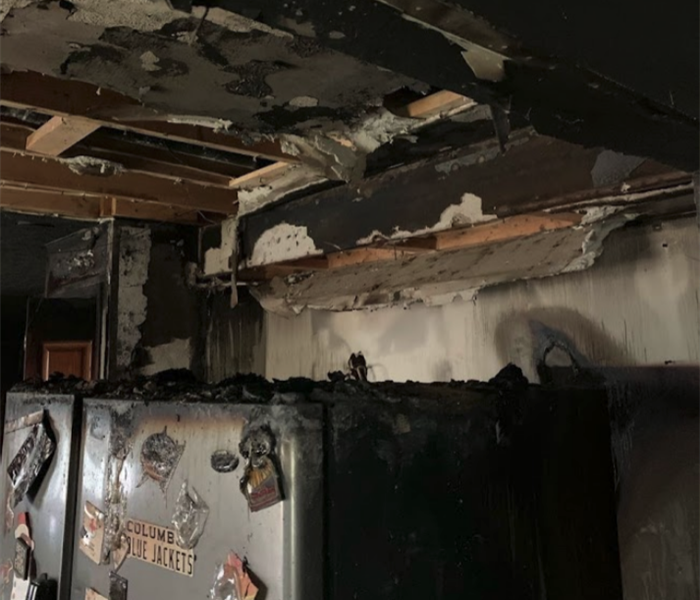 Call SERVPRO of Fairfield County at 740-756-7003 if you experience an unexpected fire
Call SERVPRO of Fairfield County at 740-756-7003 if you experience an unexpected fire
A fire in your home or business never something you expect to experience. Which is why it is important to know the 4 stages of a fire to keep you safe.
Incipient: This first stage begins when heat, oxygen and a fuel source combine, having a chemical reaction resulting in a fire. It is also known as “ignition”. There is usually a small fire, which often goes out on its own, before the following stages are reached. During this stage, recognizing a fire so early is your best chance at suppression or escape.
Growth: This stage is where the structure’s fire load and oxygen are used as fuel for the fire. During the growth stage, there are multiple factors that affect the fire including where the fire started, what combustibles are nearby, ceiling height and the potential for “thermal layering”. This is stage is when a deadly “flashover” can occur’ potentially trapping, injuring, or killing firefighters.
Fully Developed: When the growth stage has reached its maximum and all nearby combustible materials have been ignited, the fire is considered fully developed. This is the hottest stage of a fire and the most dangerous for anyone trapped within.
Decay: The decay stage is the longest stage of a fire; it is characterized by a significant decrease in oxygen or fuel, putting an end to the fire. There are two common dangers during this stage. First, the existence of non-flaming combustibles that can potentially start a new fire if they are not fully extinguished. Second, there is a danger of a backdraft when oxygen is reintroduced to a volatile, confined space.
Tips For Preventing Electrical Fires
2/10/2021 (Permalink)
According to the National Fire Protection Association, the second leading of cause of house fires in the U.S. is from electrical failures or malfunctions. Most electrical fires are caused by faulty electrical outlets and outdated appliances. The following are the most common reasons why electrical fires happen:
Old electrical sockets and unsafe appliances
Appliances that are old and overused and those that fall short of modern safety standards are the worst culprits. Frayed electrical cords, self-jointed wires, and worn out sockets that are not properly grounded are major causes of fires. They become ready outlets for directing heat and fire to carpets, rugs, curtains, and combustible plastic. Older appliances draw more power than the wall sockets can handle.
Using light fixtures that exceed the permissible wattage
A very common cause of fires is plugging lights, lighting appliances and bulbs into electrical sockets that cannot handle higher wattage levels. Antique lighting appliances may have defective wiring that makes the appliance unstable by overheating. Decorating lights with colored paper and cloth shades can increase the risk of fire when the material or fabric heats up.
Using multiple appliances plugged into an extension cord
Unrestricted use of extension cords is a major fire hazard. The risk of fire increases when your TV, home theatre, computer and other appliances are all plugged into a single extension cord. This creates excessive power load on a single socket which may not be designed to handle that load. So, there is a social and economic cost to damaged wiring!
Locating portable heaters near combustible materials
Portable space heaters that use coils are potentially dangerous when they are positioned carelessly near curtains and rugs and adjacent to beds and cloth covered furniture. The chances of inflammable material meeting the red-hot coils increase the risk of fire.
Wiring that becomes defective with the passage of time
Over a period of time you add more electrical appliances such as wide screen televisions, home theatre, microwave oven, refrigerator, and air conditioners. The outdated home wiring cannot handle the increased power load. Older wiring tends to heat up quickly and catches fire. If the breaker boxes are themselves defective, they cannot prevent overheated electrical panels from catching fire.
House Fire in the Cold Winter
2/10/2021 (Permalink)
Freezing temperatures are here and that means a lot of people trying to do what they can to stay warm. What people do not think about are the damages one can cause while trying to stay warm on a freezing cold day.
Cold weather in Fairfield County, Ohio means turning up the heat and the use of other heating methods like space heaters, heated blankets, candles, and fire places. All of these sources can light up the room if used improperly. For example, keeping them on for too long or placing some of these heat sources too close to flammable objects.
Freezing winter air contains less moisture compared to the air during other seasons throughout the year. Because of the freezing air, the physical wood structure of the home becomes drier and can lead to disastrous fires under the right conditions.
The older the home is, the higher the risk of fire possibilities. To prevent these problems, get an annual safety inspection to make sure your home is not at risk of lighting up in flames.
Fire Clean Up Process
2/3/2021 (Permalink)
“To develop a team of quality people who focus on excellent service, fairness and mutual respect.”
- SERVPRO® Mission Statement
- Structural Cleaning - After a smoke or fire damage, ceilings, walls, woodwork, carpeting and floors will often need a thorough cleaning. SERVPRO of Fairfield County will pretest to determine the extent of damage, and then use the specific equipment and cleaning products required to clean and protect the different types of surfaces found in your structure. Depending on the amount of soot, SERVPRO of Fairfield County may even be able to reduce the cost of recovery by cleaning lighter soot deposits found on some surfaces, eliminating the expense incurred with repainting or refinishing. In other cases, SERVPRO will clean to “prepare for painting”. This process deodorizes and ensures the new paint will adhere properly to the surface.
- Contents Cleaning – All of the restorable contents in affected areas will be professionally cleaned and deodorized. This includes area rugs, furniture, draperies and upholstery. SERVPRO of Fairfield County begins by carefully inspecting and testing all fabrics in the structure to determine which cleaning methods are most appropriate. SERVPRO can provide wet or dry cleaning services. Additionally, all the other restorable contents will be cleaned and deodorized to pre loss condition. This includes electronics, art, wood furniture, kitchen items, clothing, bedding, bric-a-brac and much more. Finally, SERVPRO can provide an inventory list of all “to be claimed” items if requested.
- Deodorization – SERVPRO of Fairfield County provides specialized services that rid your home or place of business of offensive odors left by fire or smoke damage. SERVPRO does not merely cover up lingering odors with a fragrance, they seek out the sources of the odor and remove them. Ask your SERVPRO explains the various deodorization methods available and which will work best for you.
Space Heater Safety
2/3/2021 (Permalink)
SERVPRO of Fairfield County has been dealing with an abundance of fire jobs during the past couple of months. A majority of the fires we have been responding to have most likely started from space heater malfunctions. There are some things you can do to help with the prevention of a space heater starting a house fire.
- Before using any space heater make sure that you inspect the heater for cracked plugs or loose connections.
- Make sure you NEVER leave a space heater on unattended, turn it off before leaving a room or going to bed and do not let animals or children near the space heater unattended.
- Keep everything that is flammable at least three feet away from the space heater (Curtains, furniture, clothing, and etc.).
- Plug in the space heater directly into the wall, do not plug into an extension cord or surge protector. Plugging it into these devices could cause the surge protector to overheat resulting in a fire.
Space heaters are one of the biggest starters of house fires, if you use these tips they can reduce the likeliness that SERVPRO of Fairfield County will be doing fire remediation work at your home.
Surge Protector/Powerstrip Safety
2/1/2021 (Permalink)
With the endless amount of accessories, appliances, and tools that are becoming more and more common in your household, it can sure be a hassle figuring out where to plug all of them in at. Many homeowners find themselves always swapping plugs or using devices such as a power strip. While a power strip can help you out in many situations, it is the mistake of relying on them too much that causes problems. Follow these tips below to ensure your safety when using a power strip in your home.
- Use only light load appliances on power strips. That includes computers, lamps, clock, etc.
- Ensure that the power strip you purchase has an internal circuit breaker. This is a very important safety measure that is designed to prevent property loss and risks of fire.
- Use power strips sparingly. They aren't designed to maintain a load for an extended period of time, and can easily overheat quickly if used to often.
- DON'T plug a power strip into another power strip (term is called "daisy chaining"). Doing this will short out appliances and highly increase the risk of an electrical mishap.
- DON'T use power strips in moist or potentially moist areas. DON'T put them in kitchens, utility rooms or basements.
- DON'T continue to use a power strip if it feels hot.
- NEVER cover, staple, tack or nail a power strip to anything. Covering can smother the strip, and provide ample flammable material in the event of a power strip failure. Puncturing can harm the cords, making room for dangerous situations.
If you experience an electrical fire from a power strip, call SERVPRO of Fairfield County at (740) 756-7003 for help with clean up.
Fire Prevention Tips
2/1/2021 (Permalink)
SERVPRO of Fairfield County understands that cooking equipment is a leading cause of fire damage and fire injuries in homes.
To help prevent fire damage, SERVPRO of Fairfield County shares these tips. They make more sense than not cooking at home.
- Many kitchen items can catch fire, including dish towels, oven mitts, recipes, wooden tools, and loose clothing
- Never operate the stove or oven when you are tired or have been drinking alcohol
- If you are frying, broiling, grilling, or boiling food, stay in the kitchen. If you leave, even for a short time, turn off the heat
- Keep flammable items at least three feet from the stovetop
- Do not allow children within two to four feet of the stove or oven
- If you must leave the house while cooking of any kind, turn off the heat sources
Remember that fire is fast. If you cannot contain a fire immediately, leave and bring everyone with you. Call 9-1-1 from OUTSIDE.
SERVPRO of Fairfield County reminds you that fire prevention is the best strategy against fire damage.
Smoke Damage
1/8/2020 (Permalink)
After the fire is out and all the rescue workers are gone. Getting your property back to pre loss condition as fast as you can will be your next concern.
SERVPRO of Fairfield County is here to help. We respond within one hour of your call and start the mitigation services approximately four hours after notification of the loss. Our services help to ensure your belongings and property are restored to pre loss condition when possible.
We can either clean on site or, if necessary, move smoke damaged contents to our warehouse for cleaning. Contents would be cleaned and restored using our state-of-the-art techniques then returned to your home after all mitigation work is complete.
Call SERVPRO of Fairfield County at (740) 756-7003.
Are You Prepared in Case of a Fire?
1/8/2020 (Permalink)
PLAN AND GET READY
A fire in a home or business is one of the most common disasters. Fires cause more deaths than any other type of disaster. But fire doesn't have to be deadly if you have early warning from a smoke detector and everyone in your family knows how to escape calmly. Please be serious about the responsibility for planning for and practicing what to do in case of a fire. Be prepared by having various household members do each of the items on the checklist below. Then get together to discuss and finalize your personalized Fire Plan. Install smoke detectors outside each sleeping area and on each additional level of your residence. Keep new batteries on hand.
New smoke detectors installed
Batteries purchased
Test smoke detectors once a month
Start a chart and sign it after each round of tests.
Family member/ Employee checks smoke detectors.
Look at the fire extinguisher you have to ensure it is properly charged. Use the gauge or test button to check proper pressure. If the unit is low on pressure, damaged, or corroded replace it or have it professionally serviced.
Get training from the fire department in how to use the fire extinguisher.
Family member/Employee examines extinguisher.
Family member/Employee have been trained to use the extinguisher.
Draw a floor plan of your home; mark two fire escape routes for each room.
Pick a safe outside place to meet after escaping from a fire.
Find a Meeting place
Practice a low-crawl escape from your bedroom. Try it with your eyes closed to see how well you could do in thick smoke.
MAKE YOUR HOME FIRE SAFE
- Smoke detectors save lives. Install a battery-powered smoke detector outside each sleeping area and on each additional level of your home.
- Use the test button to check each smoke detector once a month. When necessary, replace batteries immediately. Replace batteries at least once a year.
- Have a working fire extinguisher in the kitchen. Get training from the fire department in how to use it. Also include in the kit written instructions on how to turn off utilities at your house.
- Conduct periodic fire drills, so everyone remembers what to do when there is a fire.
PLAN YOUR ESCAPE ROUTES
- Determine at least two ways to escape from every room of your home. If you must use an escape ladder, be sure everyone knows how to use it.
- Select a location outside your home where everyone would meet after escaping.
- Practice your escape plan at least twice a year. Once you are out, stay out!
ESCAPE SAFELY
- If you see smoke in your first escape route, use your second way out.
- If you must exit through smoke, crawl low under the smoke to escape.
- If you are escaping through a closed door, feel the door before opening it. If it is hot, use your second way out.
- If smoke, heat, or flames block your exit routes, stay in the room with the door closed. Signal for help using a bright-colored cloth at the widow.
- If there is a telephone in the room, call the fire department and tell them where you are
How to Clean Smoke Damage After a Fire
12/5/2019 (Permalink)
The worst part of most house fires isn’t necessarily the damage from the actual fire but the damage caused by the smoke and soot of the fire. Most house fires that are contained and put out quickly leave little to no damage. If the fire is in the oven or on the cooktop, the flames may cause damage to the oven, hood, and back wall. If replacing the oven or cleaning up the oven was the only thing needed, that wouldn’t be so bad. Unfortunately, it’s the smoke from the fire that can quickly spread that can leave lasting damage if not cleaned up properly.
In this blog, we will go over some tips to clean up “minor” smoke damage after a fire. We use the word “minor” because smoke damage can quickly turn into a much bigger problem as it spreads quickly. The other problem is that the homeowner may exacerbate the smoke damage by using the wrong cleaning supplies and chemicals. This leads us to the first tip.
Assess the Smoke Damage Before Cleaning
Once the fire has been safely put out, check the area for smoke damage. If you see that the smoke has gone up the walls and to the ceiling, it is usually best to call a professional to clean up. The reason is that it can be difficult to remove smoke from porous ceilings and walls. Also, if the smoke is visible on the ceiling and walls, there’s a good chance that it has been carried elsewhere. Fire damage restoration professionals will know where to look and how to clean the smoke damage. Also, smoke can easily slip behind appliances, through cracks, and other hard to reach areas which if not cleaned could leave that the smell of smoke lingering behind.
Air Out the Room
If you experienced a small kitchen fire, open the nearest window and/or door to let fresh air in. This will allow any airborne soot or smoke to hopefully blow out of the house. It’s also a good idea to turn off your central air or heat so the smoke isn’t sucked up into your air ducts. Once the smoke has dissipated and you’ve gotten plenty of fresh air circulating through the area, you can turn back on your central air or heat. It is, however, a good idea to check your air filter on your furnace and change it out if you smell any smoke from it. Another good idea is to use box fans to push the air out through your open windows and/or doors.
Clean Up the Fire Extinguisher Residue
If you use a fire extinguisher to put out the fire, you most likely used the common ABC dry powder fire extinguisher. It’s important to clean up the dry powder from any appliances or metals as the powder can be corrosive over time. A simple wet rag can remove the powder from any surfaces like an oven, sink, or refrigerator. Also with small kitchen fires, the powder probably spread further than the actual smoke damage, so you want to be thorough in examining all of the surfaces and areas around where the fire occurred.
Vacuum Up Any Fire and Soot Debris First
Before using towels and cleansers to wipe the surfaces, you will want to use a vacuum to remove any loose debris or soot from the damaged area. The debris could scratch surfaces like cooktops if using a towel to wipe the surface. Use the brush attachment of your vacuum to lightly dislodge any debris so the vacuum can suck it up. You make also want to use a broom to sweep up any debris but be careful not to use too much force as you could scratch the surfaces or make the stains worse.
Don’t Use Liquid Cleaners Just Yet
This is where most people would tend to grab a towel and a liquid cleaner to remove the smoke from the walls, ceiling, and other surfaces. Doing this usually makes the damage worse and harder to clean up. Using liquid cleaners and a towel at this stage can sometimes smear the smoke stains or push them deeper into the surfaces especially walls and ceilings. To get most of the soot and smoke off of surfaces, you need to use a dry chemical sponge. This is a special type of sponge that is impregnated with chemicals that are designed to remove soot and smoke. By gentling wiping the surface, the sponge absorbs and/or picks up the soot and smoke from the surface. If the smoke damage is minimal, this can be an easy task but if there is extensive smoke damage, this can be an enormous project that is usually best left to the professionals.
Next, Wash the Surfaces with Professional Cleansers
Once you’ve removed most of the smoke and soot from the surfaces with the dry chemical sponge, you’ll then want to use professional cleansers and a towel to wipe down the surfaces. Some of the different cleaners that people use are commercial soot/smoke cleaner, white vinegar, dish soap, and trisodium phosphate (TSP). A professional smoke damage restoration company will know better what cleaners to use and when. Some cleaners may remove the smoke and soot stains but leave the smell behind. Some may kill the smell with natural, biologically-activated enzymes but not remove the stains.
The Best Step to Take is Call the Professionals
Removing the stains and smells from smoke and soot is not a simple and easy process. We just went over some steps that may work for smooth surfaces but what if the smoke gets into fabrics or furniture? That is why it is usually best to call the professionals to handle the cleanup and restoration of fire and smoke damage. Fire damage restoration experts, like us at SERVPRO of Fairfield County, have the knowledge, expertise, tools, cleaning agents, and equipment to effectively remove all the stains and odors and damage from a home fire. Contact us 24/7 when the next time disaster strikes at your home or business.
Identifying the Type of Smoke & Soot is the First Step
12/5/2019 (Permalink)
Not all smoke is created equal. Smoke and soot are the byproducts or residue of a fire. The type of smoke damage depends entirely on what burned in your home or business. In the blog below, we will cover the main types of smoke damage and how the smoke and soot residue is different.
Types of Smoke Damage
Wet Smoke
Wet smoke is one of the hardest to clean up and can easily make a mess. This type of smoke results from smoldering fires with a low temperature. The smoke is thick and sticky and smears easily if touched. It easily clings and builds up on walls, furniture, ceilings, and other surfaces. It is very difficult to clean up and it is always a good idea to contact a fire damage professional to clean it up. It also leaves a strong lingering odor if not properly cleaned up.
Dry Smoke
Dry smoke is usually much easier to clean up. It comes from much higher temperature fires like paper, wood, or synthetic materials. The smoke is usually less black and more powdery from paper and wood. With dry smoke, you have to worry about it penetrating small cracks and grooves in everything it comes into contact with. This can include wood, wallpaper, fabrics, carpets, wood floors, tile grout, and electronics. While it is easy to clean off of flat surfaces, if you don’t get it out of all the crevices and spaces, it will leave behind a stinky odor.
Protein Smoke
Protein smoke usually occurs in the kitchen as a result of food catching on fire in the oven or on the stovetop. Protein smoke also naturally occurs just from cooking and can build up on surfaces over time. The smoke is usually light in color and tends to discolor surfaces surrounding the cooking appliances like the ceiling, walls, and counters. The smell of protein smoke can be very strong and stinky especially from a large food fire in a kitchen. The smoke residue is also very greasy which makes it really difficult to clean. Cleaning up this residue requires professional cleaning materials that are made for protein-based smoke residue.
Petroleum Smoke
Petroleum smoke is usually the result of a fire from cooking oils or fuel oils. Petroleum smoke is very dark and thick. Due to the flammability of the oils, the smoke is usually pretty significant and can quickly fill up a room or home. It can easily discolor any surface it comes into contact with including ceilings, walls, and floors. It can also ruin any porous materials like furniture, flooring, and drapes if not treated quickly. Due to the amount of smoke residue it can cause and the difficulty in cleaning it, it is highly recommended that you contact a fire damage restoration company like SERVPRO of Fairfield County.
Preserving Your Property After a Fire
12/5/2019 (Permalink)
Two Terms You'll Hear After The Fire
Roof Tarping: The Fire Department will often vent the roof of a structure fire to help in their efforts to control and extinguish the blaze. To vent the roof, they use an ax or saw to cut a hole in the roof. We use a thick, weatherproof tarp to cover any holes in the roof to minimize secondary damage from precipitation or animals.
Board-Up: We use durable plywood to cover any broken windows or doors that cannot be locked, this is done to preserve the structure and to keep the home safe from possible break-ins and exposure to the outside environment.
SERVPRO, Faster To Any Disaster
Once the fire has been put out, it's essential to call us, SERVPRO of Fairfield County as soon as possible. Even if it's in the middle of the night, we're available 24/7 to help. We are ready to take your call and take action no matter the time of day or night. Sometimes the fire department may need to break windows and cut holes in the roof to vent the house so that they can fight the fire properly. If that happens to your property, we can fully secure the structure even in the middle of the night. Call us at 740-756-7003, or click here, and we'll help you and your family get back the life you had before the flames took over.
Fast Action to Help Save Your Property
In many home fire situations, there may be damage to the exterior of the home that would cause the outside elements, like rain, to get inside. If windows have been broken, doors kicked in, roofs damaged or exterior walls damaged from the fire, we will first board up any windows or doors and cover any roof or wall damage with tarps to keep the elements from causing further damage to your home.
Protecting What's Inside Your Home
It's crucial to secure the structure shortly after the fire is extinguished. There are security and safety issues to keep in mind. The contents and personal effects of the homeowners need to be protected. By covering any broken windows or holes, we can keep out any weather elements or curious critters looking for a place to nest. After we complete the emergency board-up services, you can count on the experts at SERVPRO of Fairfield County to fully restore your home or business.
How Our Professionals Deodorized Your Home After A Fire
12/4/2019 (Permalink)
How Your Home Gets Deodorized After a Fire
You might assume that harsh odors present after a fire loss in your Fairfield County home gets related to smoke damage, but this is not always the case. Part of our ability to successfully navigate proper deodorization of your property after emergencies hinges on our knowledge of industry practices. Our professionals get trained specifically to identify foreign and noxious odors present in the house after a loss incident, and in doing so, can develop the best approach for removing them.
Smoke is a common contributor to harsh odors and other fire damage, but is not the only factor to consider. The combustion of specific types of materials, gasses that get released into the environment, and other destroyed items can all create foreign and challenging scents of their own. Our SERVPRO professionals can look to isolate these individual sources and eliminate their hold on your home, instead of non-effective practices like masking odors and taking shortcuts.
As a team, we rely on multiple machines that can help with this odor elimination process, and much of the decision on the specific unit relates to the severity of the damage and how widespread this condition has become. Units like our hydroxyl generator, for instance, have a stationary operation that works to affect a broad area with central placement, whereas our portable thermal foggers can offer a more concentrated and direct approach by moving with our technicians from one space to another.
Deodorization is often one of the final steps of recovery, though efforts made through the mitigation process can often work to reduce the severity of these odors. Debris and residue removal can both substantially reduce the strength of present odors because of the elimination of primary sources, helping them to circulate continually.
Regardless of the situation you face, We’re Faster to Any Size Disaster and can help you however you need. Give us a call today at (740) 756-7003.
Protecting Your Pets From Residential Fires
7/16/2018 (Permalink)
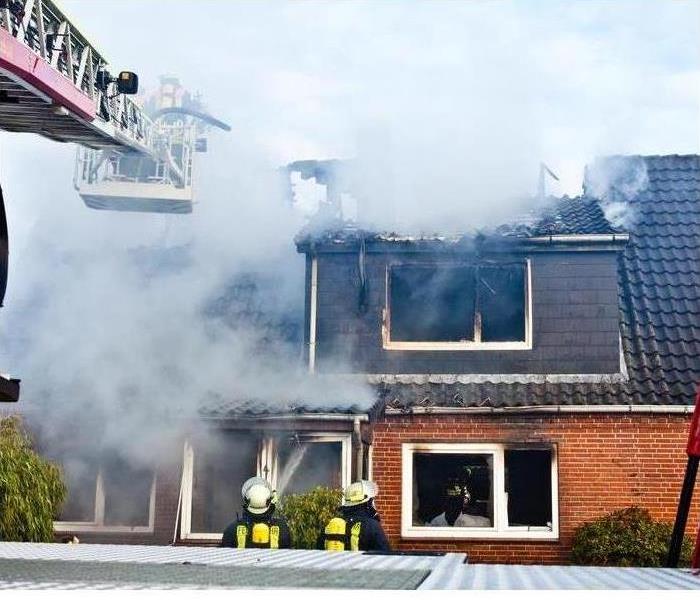 Protect Your Pets
Protect Your Pets
While the idea of a fire erupting in your home is never easy to consider, the potential of your beloved pets getting hurt during any fire emergency is that much worse. Therefore, it’s important to not only create a pet preparation plan in the event of a house fire but to take precautions with pet safety before a situation ever occurs. Here are some important ways to protect your pets before and after a dangerous situation occurs.
Prevent a mishap by always extinguishing open flames and keeping them at high levels out of your animal’s reach. Any moving flames seen from candles, BBQs, fireplaces and more can easily draw your pet’s attention. Therefore, it’s vital that you always put out any flames before leaving a room and keep them away from reach, either placed up high or properly covered and untouchable.
Address any problem areas by doing a regular inspection around the home. Check for any loose wiring, reachable appliances or unstable devices that can be knocked over, as they can all turn into possible fire hazards.
If a fire emergency does break out, be sure your pets have their identification in a safe place. Keep any ownership and vaccination records in a fireproof box, and leave your pet’s tagged collars on them at all times to ensure firefighters or other rescuers can identify who your pets belong to and where to secure them.
Plan an escape route with your pet. Practicing fire drills and showing your pets where their escape routes are can give them a helpful head start should a fire erupt. Leave leashes and carriers easy to reach and keep your animals near an entrance while you’re away so they can be quickly located by professionals.
Protecting your pets by taking preventative measures in your home is crucial for pet safety and your peace of mind. After all, if a fire emergency occurs, knowing you’re prepared ahead of time is crucial to staying calm and getting everyone out in a timely manner.
3 Reasons You Should Have a Fire Extinguisher in Your Home
7/16/2018 (Permalink)
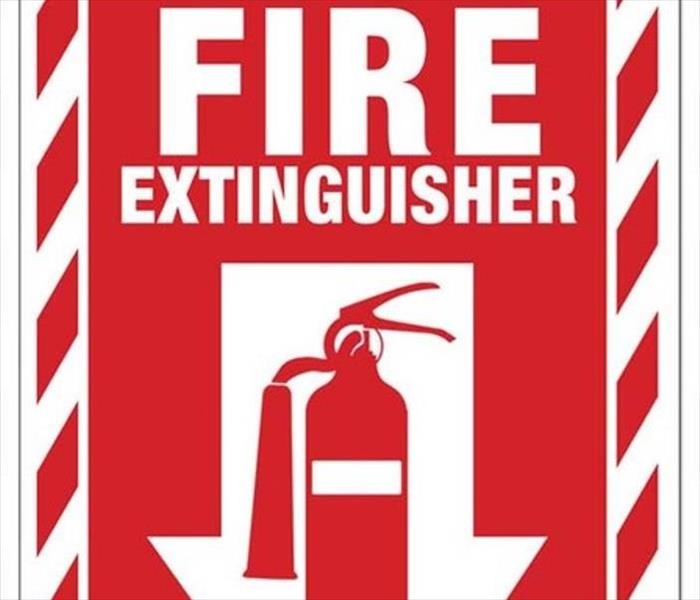 Protect Your Home With A Fire Extinguisher
Protect Your Home With A Fire Extinguisher
By taking the simple step of purchasing a fire extinguisher, you can help defend your home against fires. Extinguishers can put out fires that water cannot, making them extremely useful in the event of a kitchen fire or other emergency.
1. Protect Your Home
While they should not be used as a replacement for smoke detectors, fire extinguishers can be a great way to add another layer of safety to your home. Stopping fires before they get out of control can help prevent property damage and keep you and your family safe. What could have been a devastating fire could turn out to be just a little mess.
2. Stop All Types of Fires
Fire extinguishers can be separated into different categories. Some of these may be more useful for your home than others.
The different classes include:
* Class A: puts out fires on ordinary materials
* Class B: puts out grease fires and other flammable liquids
* Class C: puts out electrical fires
* Class D: Puts out flammable metals
For use in your home, you can purchase an A-B-C extinguisher that will put out ordinary fires as well as grease fires and electrical fires. It can be an especially good idea to keep one in your kitchen, as this can be a high-risk area for fires.
3. Be Cost Efficient
Fire extinguishers can be available for a low cost, sometimes as little as $10 a unit. This can make them a great investment, as they could potentially save you a lot of money in property damage as well as keeping you safe.
Having a fire extinguisher and knowing how to use it can help you stop emergencies, such as kitchen fires, from getting out of control. While it is a good idea to focus on your personal safety before worrying about property, an extinguisher can still be a useful way to save your home from extensive fire damage. Relatively inexpensive, an extinguisher can be a great addition to your home’s fire defenses.
How to Get Smoke Out of Your House After a Fire
7/13/2018 (Permalink)
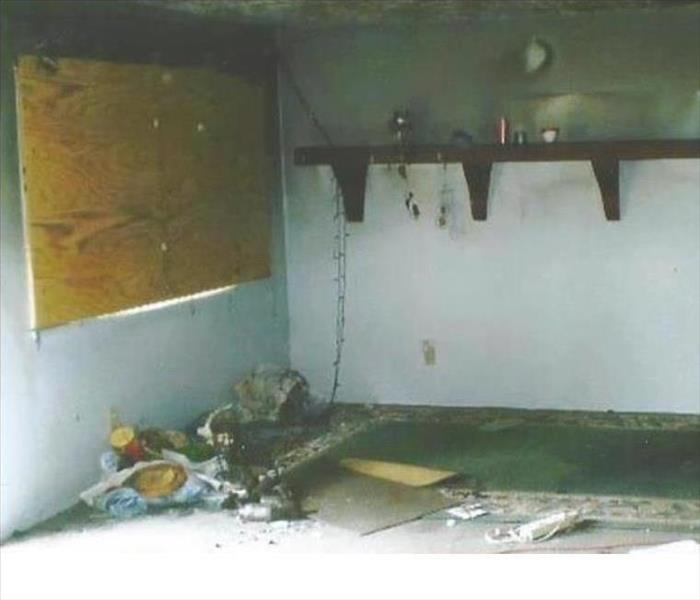 How to Get Smoke Out of Your House After a Fire
How to Get Smoke Out of Your House After a Fire
Almost everyday homes experience an accidental fire inside their homes. Many times it’s a kitchen meal gone bad with a flame up on the cooktop or something that is cooked “well done” in the oven. Sometimes it’s a candle that someone forgot to blow out before leaving the room.
Luckily, most of these fires are extinguished quickly and result in little damage from the actual fire. Unfortunately, the smoke from these fires is what causes the most damage to homes. So what is one to do if they should experience a fire in their home that causes a lot of smoke? Below we cover what to do and what not to do.
#1 Remove the Cause of the Smoke
Only do this if it is safe. If you have burnt something in the oven, take it to the nearest door and put it outside. The item is most likely extinguished but may continue to let off smoke for a while.
Do not put the smoking item outside if it isn’t extinguished completely and don’t take it outside if you have to go through several rooms to get outside. You want to isolate the smoke rather than spread it throughout your home. If you don’t remove the burned item immediately, do it once it has cooled down.
#2 Open All Nearby Windows
Wherever the smoke has occurred, you want to immediately open any nearby windows to allow the smoke to blow out and fresh air to flow in.
You don’t want to open windows in rooms or areas where there is no smoke because this could cause the smoke to flow throughout your home and exit the opened windows. Again, you want to isolate the smoke to the area it occurred which brings us to the next important step.
#3 Turn Off Any Ceiling Fans and HVAC System
To help reduce the smoke from spreading throughout your home, you want to turn off any ceiling fans in the affected area. You also want to turn off your HVAC unit as it can funnel the smoke through your air ducts and into the rest of your home. This can result in not only having to deal with smoke cleanup in other rooms but throughout your air ducts also.
If you have box fans, you will want to put these in your open windows and turn them on to pull the smoke out of your home more quickly.
#4 Wipe Down Any Solid Non-Porous Surfaces
If you have granite countertops or dishes or glass windows, you can wipe them down with a cleaning solution to remove any soot or burnt particulates that gathered on the surface.
Be careful about scratching glass or other easily scratchable surfaces if the soot is very grainy. Even the smallest of particles can cause a scratch if you aren’t careful. If you are worried about damaging a solid surface, always err on the safe side and have a professional smoke remediation expert clean it.
#5 Do Not Wipe Down Porous Surfaces
The smoke from the fire most likely caused some discoloration on the ceiling about the fire and on the walls nearby. The smoke could have also gathered in the corners of the room causing discoloration there.
While it may seem that wiping down the ceilings and walls would be easy to do, most people actually make it worse due to the porous nature of walls and ceilings. Rather than removing the soot and smoke discolorations, wiping it down could smear the soot and embed it further into the surface creating a bigger mess.
#6 Call the Smoke Damage Repair and Restoration Experts
If you have ceilings and walls and sometimes wood floors that are discolored from the smoke and soot, it’s best to call the smoke damage repair experts at SERVPRO of Fairfield County. They have the tools and the expertise to safely and effectively remove the smoke damage and restore it back to new.
If you should suffer extensive smoke and/or fire damage, they can most definitely help get your home cleaned up, repaired and restored as quickly as possible. They have dealt with all types of fire and smoke damage, and are ready to help you if you need them.
What To Do Following a House Fire
6/1/2018 (Permalink)
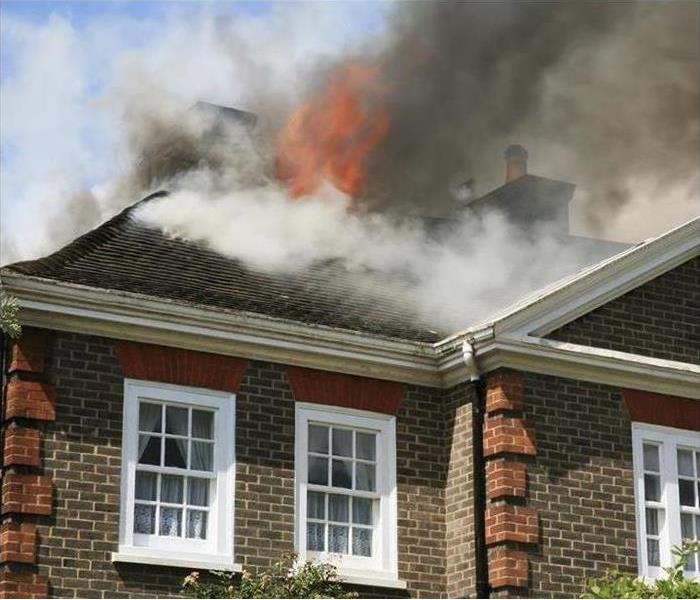 Fire Damage Can Be Fixed By SERVPRO
Fire Damage Can Be Fixed By SERVPRO
A house fire can lead to a complex series of events. However, homeowners who familiarize themselves with the fire damage remediation process can simplify and streamline the process of home restoration by making coherent choices. Learn more about how to realize this important objective by reviewing the short outline provided by SERVPRO.
Put Your Safety First. Once a major fire transpires in your home, there will be a wide range of health and safety hazards present. For this reason, it's very important for you to put you and your family's safety first. For starters, make sure that you do not reenter your residential property until you receive the go-ahead from an authoritative source as the fire department. Factors like falling debris, electrical hazards, smoke contamination, and the compromised structural integrity of your property could result in an accident. Also, be sure that you do not attempt to complete any aspect of the restoration process on your own. Doing so can result in significant injuries or illness.
Call Your Insurance Company. In addition to putting your safety first, make sure that you call your insurance company immediately. Your insurance agent will send out an adjuster enabling you to start and complete the process of filing your claim. The adjuster may also help you with the photographing all damaged areas of your property. Be sure that you do not overlook this important process. The pictures you take of damaged materials and structural elements can help determine how much coverage you receive.
Contact A Premier Fire Damage Restoration Company like SERVPRO. Our rep will inspect the property and assess the damage using our CCIS generated form. The result is an inventory listing all damaged items and building materials. We can help manage the insurance paperwork and work closely with you and your insurance adjuster to expedite the restoration process and claim. We will provide the following while also relieving you of some stress that can be overwhelming.
• Rapid response. Local with 24/7 availability.
• Communication of procedures.
• Construction of a detailed estimate.
• Prevention of ongoing damage. Water removal, protection of personal items.
• Prevention of cross-contamination. Inhibit the continued circulation of smoke and soot. Disinfecting and mold remediation.
• Proper cleaning and processing of the entire remediation project. On-site and shipped out utilizing the standards set forth by the Institute of Inspection, Cleaning and Restoration Certification, (IICRC).
• Providing effective odor control. Foggers, Ozone machines, air movers, and dehumidifiers.
Trust The Professionals from SERVPRO . Once fire damage has impacted your home and life, you may feel a sense of despair, and anxiety. Allow us, industry experts with extensive experience, to complete each component of the restoration process following a fire. We will keep you informed and offer a final walk-through to ensure your satisfaction with the restored condition of your home.
SERVPRO Suggests Safety First for Any Fire Damaging Event to Your Home
6/1/2018 (Permalink)
 Protect Your Family and Property From Flames
Protect Your Family and Property From Flames
How a homeowner reacts to a house fire should follow the tenet of "Safety First." A large-scale fire, can be repaired and restored. However, knowing what to do during and after a fire can help save you money and limit the structural damages impacting your property. SERVPRO suggests that learning what steps to take in the face of a house fire may save a life.
During a Fire
1. Check Doors before Entering A Room. Before you open a door, be sure to check the door. If you see smoke coming from under the door, do not enter. You can also touch the doorknob to see if it is hot. If so, avoid this door and seek another exit. If you cannot find a door to exit the premises safely, you will need to use a window. Hopefully, you had fire drills with an evacuation plan for such an emergency.
2. Leave The Premises. Once you're aware that a fire is present, don't panic. Instead, focus on quickly removing you and your family (do a head count) from the property. Although you may want to grab some valuables, doing so is not advisable, if super-heated air or roaring flames are close. Safety first.
3. Be Aware Of Smoke. Smoke inhalation, charged with temperatures reaching 1200 degrees F, is the leading cause of death during a house fire. Stay low to the floor as possible while exiting your home.
4. Do A Head Count. DON'T PANIC if someone is missing. If reentry is not safe, tell the 1st responders so that they can find the missing family member.
Chemical Fire at a Restaurant
3/26/2018 (Permalink)
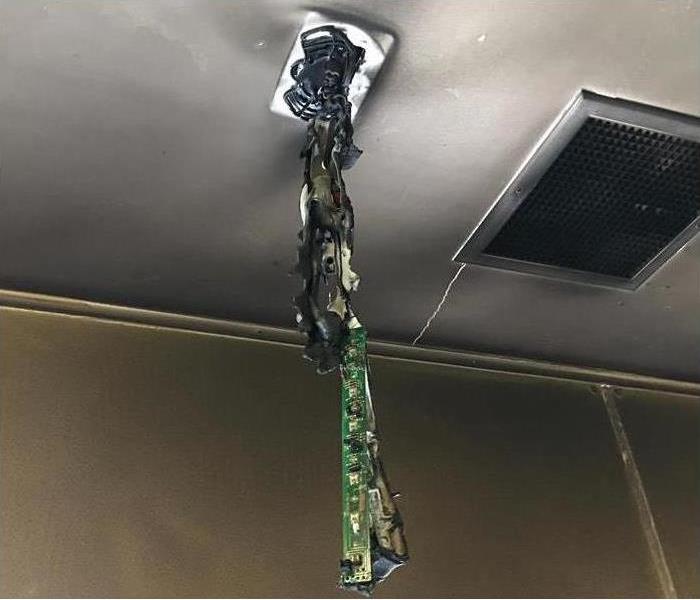 Exit Sign
Exit Sign
A restaurant owner was quite surprised when he arrived at his place of business one morning.
When he arrived at his restaurant, he knew there was a problem due to the black soot on the outside wall of his restaurant. Immediately he thought there was a fire inside and called the fire department.
When they arrived and opened the doors there was no fire burning, however, there was considerable heat damage.
It appeared that cleaning rags with powerful chemicals placed in a laundry hamper had ignited at some point in the evening. As the fire tried to take hold it consumed all of the oxygen in the room and eventually is had burned itself out.
This did not stop it from smoldering, however, and the intense heat in the room caused everything plastic to eventually melt to a point of unrecognition.
The picture posted here is of the exit sign that hangs over the outer door.
SERVPRO was called to estimate cleaning and repairs.
Use Caution When Tending To Home Projects
7/10/2017 (Permalink)
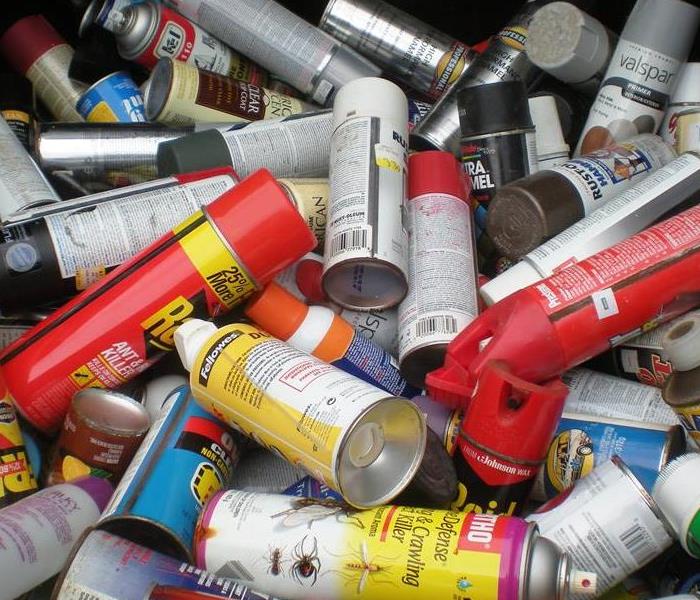 Assorted Potential "Dangers"
Assorted Potential "Dangers"
It’s that time of year to finally get the household projects done that have been piling up. Many of these projects involve paint, stain, and/or gasoline. Aside from the obvious dangers most don’t consider that rags that contain these chemicals can also catch fire. “The oils commonly used in oil-based paints and stains release heat as they dry. If the heat is not released in the air, it builds up. That is why a pile of oily rags can be dangerous. As the rags dry, the heat is trapped. The heat builds up and finally causes a fire.”
Did you know?
“An Average of 800 home fire per year are started when oily rags catch fire or are ignited”
If your home project involves stains or chemicals that get onto rags here is a few tips to keep you safe:
- “Never leave cleaning rags in a pile. At the end of the day, take the rags outside to dry.
- Hang the rags outside or spread them on the ground. Weigh them down. Do this so they do not
blow away. Make sure they are not in a pile. Keep them away from buildings. - Put dried rags in a metal container. Make sure the cover is tight Fill the container with a water
and detergent solution. This will break down the oils.”
For more tips to keep you safe during your projects visit: http://www.nfpa.org//~/media/files/public-education/resources/safety-tip-sheets/oilyragssafetytips.pdf
SERVPRO of Fairfield County Let our professional team do the cleanup with the proper procedures to keep you, your home or company safe. 740-756-7003
Matches & Lighter Safety
5/31/2017 (Permalink)
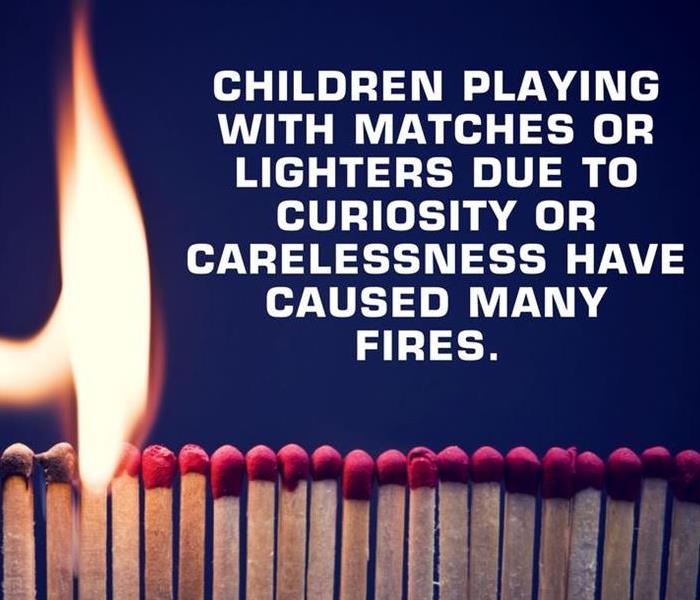 It Only Takes One Match
It Only Takes One Match
It is very IMPORTANT to teach children that playing with matches is NEVER appropriate. Matches and lighters should always be kept out of reach of children for their safety and for the safety of others. not only is it dangerous to the area around then, they could cause serious injury and even death to the child.
Fires and property damage associated with children playing with matches and lighters are common events in the United States. It is difficult to put an exact number on it statistically, because the actual source of the fire is often times hidden due to embarrassment or being scared of the consequences of their actions.
Check with your local fire department for classes that teach young children about fire safety.
#SERVPROCARES
Fire Damage from Grill
5/23/2017 (Permalink)
Burning charcoal was the cause of this fire damage to a home. This before picture shows the extent of the damage caused by the charcoal. SERVPRO was able to respond immediately and help clean and deodorize this home.
Different Types of Smoke
There are two different types of smoke–wet and dry. As a result, there are different types of soot residue after a fire. Before restoration begins, SERVPRO of Fairfield County will test the soot to determine which type of smoke damage occurred. The cleaning procedures will then be based on the information identified during pretesting. Here is some additional information:
Wet Smoke – Plastic and Rubber
- Low heat, smoldering, pungent odor, sticky, smeary. Smoke webs are more difficult to clean.
Dry Smoke – Paper and Wood
- Fast burning, high temperatures, heat rises therefore smoke rises.
Protein Fire Residue – Produced by evaporation of material rather than from a fire
- Virtually invisible, discolors paints and varnishes, extreme pungent odor.
Have Questions about Fire, Smoke, or Soot Damage?
Call Us Today – 740-756-7003
Replacing Your Furnace Filter
4/17/2017 (Permalink)
Pretty soon it will be time to turn off your heat and start using your air conditioner. The first thing you will need to do is replace your furnace filter. There are many styles of filters, including ones that specifically filter for allergens. First you need to know how to replace them, and how often.
“What kind of filter do you have? Start by turning off the furnace. Remove the existing furnace filter, which will be located inside the furnace or inside the return air vent. Look for an arrow on the filter indicating airflow direction. Using a permanent marker, draw the airflow direction on the outside of the furnace, so you'll always know the right way to install the filter. Then note the furnace filter size, which will be printed on the cardboard frame.”
For more information, please continue reading at:
http://www.consumerreports.org/home-air-purifiers/how-to-replace-furnace-filters/
Are You Using Your Fireplace Vent Properly?
4/12/2017 (Permalink)
“A fireplace is often the main feature in a room. Pictures and keepsakes are displayed on the mantel, and during the holidays, the pictures are exchanged for Christmas stockings. A fire crackling in the fireplace adds to the ambiance while the heat it generates helps to warm the area. A closed vent can cause smoke to billow into the room, but using the fireplace vents properly ensures enough air feeds the fire and the smoke escapes up the chimney.
Prepare your fire in the fireplace by placing two dry, seasoned logs onto the grate. Place a kindling between the two logs such as dry leaves, twigs, bark, dried pine needles or small pieces of split, dried softwood. Loosely crumple old newspaper and push it under the grate. “
For more information, please continue reading at:
http://homeguides.sfgate.com/use-fireplace-vents-properly-27448.html
Let our professional team do the cleanup with the proper procedures to keep you, your home or company safe. We are available 24/7 for all your emergency needs. No job is too small or too big for our teams!
Why Trusting A Restoration Specialist After A Fire Is Important
3/20/2017 (Permalink)
Making Fire & Water damage, "Like it never even happened."
Because of the convection pattern that flames typically form during ignition, smoky residue saturates every opening. The soot constructs up in layers that may end up being solidified and tough to eliminate which is another reason to leave the cleaning to a specialist. When the cleaning teams do arrive, they promptly different salvageable items from charred debris, taking the things creating the strongest odors out for cleaning. Following a fire, wall surface areas can be harmed by soot. Non-water based cleaners need to be used to remove soot from walls. These kinds of chemicals should be handled by a specialist due to the fumes and toxicity. Water-based cleaning items can cause spots to bleed into plaster walls which is why a trained specialist should be left to deal with these chemicals. Most importantly, a restoration effort reduces the after-effects a blaze can have on the health of those who return in.
If a homeowner does not have the property restored by a professional, the results can be found later on down the line. To an untrained eye they might believe the issue has been fixed, they experience the remaining impacts of indoor air pollution for numerous months later on in the form of increased respiratory discomfort. Companies like SERVPRO of Fairfield County are leading experts in fire restoration. They are trained to help remove your belongings as well as cleaning and storing them until your property has been restored to its original condition.
Call SERVPRO of Fairfield County (740) 756-7003
"Like it never even happened."
Hiring Cleaning Professionals
3/17/2017 (Permalink)
Hiring Cleaning Professionals In Fairfield County
If you are a homeowner and are dealing with fire damage, trying to take on the cleanup yourself can be a difficult job. Though it is certainly possible to restore small areas of damage on your own, a home that has significant damage due to fire, such as on the roof, walls or floor, is best left to professionals. Though you might think that cleaning a home in with residential fire damage is as easy as removing and replacing the scorched areas, there is much more to consider with this type of problem. With the assistance of a professional company, you will have the best chance to reduce the odds of a total loss.
Cleaning Up After the Chaos
Most homeowners realize that they need to clean up quickly after a fire, but what they don't understand is that this initial cleanup is not only toxic for a person's health but could also be extremely difficult to perform. Usually, an inspector from the insurance company will come to view the damage, but after they leave, it often requires the use of a HAZMAT suit to thoroughly protect the lungs when cleaning up this large of a mess.
Fire Damage Isn't the Only Issue
Fire in not only leaves charred and smoky belongings in its wake; it also leaves water damage as water is necessary to control the flames. Water damage can sometimes be more difficult to deal with than fire damage because most homeowners do not have the tools or the knowledge to handle it. Also, any surface that has water sitting on it for more than about 18 hours is already experiencing mold and bacteria growth. In this case, the best practice is to throw the surface out as it is too difficult to efficiently clean; leaving the mold and bacteria on the surface can lead to serious respiratory issues in the future.
Don't Forget About the Smoke Damage
Water and fire damage are only part of the story when dealing with a home with residential fire damage. Smoke is also an issue because not only does it change the look of surfaces; it also leaves an odor that is difficult to remove. To remove the smell of smoke, special cleansers are required. Also, keep in mind that even a small fire can push the smoke through the home, and smoke damage can occur in areas of the home that were never touched by fire. This means every surface of the home must be treated for smoke damage even if the fire occurred in another area of the home.
Locally Owned Company with National Resources
If you have recently experienced a fire in your home, it is best to call upon the pros. When a fire occurs in your residential property, we have the skills and equipment to help. As a locally owned and operated business, SERVPRO of Fairfield County is available to quickly respond to your home following a fire. Call us today at (740) 756-7003.
Fairfield County Smoke and Soot Cleanup
9/19/2016 (Permalink)
Smoke and soot is very invasive and can penetrate various cavities within your home, causing hidden damage and odor. Our smoke damage expertise and experience allows us to inspect and accurately assess the extent of the damage to develop a comprehensive plan of action.
Smoke and soot facts:
- Hot smoke migrates to cooler areas and upper levels of a structure.
- Smoke flows around plumbing systems, seeping through the holes used by pipes to go from floor to floor.
- The type of smoke may greatly affect the restoration process.
Different Types of Smoke
There are two different types of smoke–wet and dry. As a result, there are different types of soot residue after a fire. Before restoration begins, SERVPRO of Fairfield County will test the soot to determine which type of smoke damage occurred. The cleaning procedures will then be based on the information identified during pretesting. Here is some additional information:
Wet Smoke – Plastic and Rubber
- Low heat, smoldering, pungent odor, sticky, smeary. Smoke webs are more difficult to clean.
Dry Smoke – Paper and Wood
- Fast burning, high temperatures, heat rises therefore smoke rises.
Protein Fire Residue – Produced by evaporation of material rather than from a fire
- Virtually invisible, discolors paints and varnishes, extreme pungent odor.
Our Fire Damage Restoration Services
Since each smoke and fire damage situation is a little different, each one requires a unique solution tailored for the specific conditions. We have the equipment, expertise, and experience to restore your fire and smoke damage. We will also treat your family with empathy and respect and your property with care.
Cleanup After Fire Damage
5/16/2016 (Permalink)
Hiring Cleaning Professionals After Fairfield County
If you are a homeowner and are dealing with fire damagte in Fairfield County, trying to take on the cleanup yourself can be a difficult job. Though it is certainly possible to restore small areas of damage on your own, a home that has significant damage due to fire, such as on the roof, walls or floor, is best left to professionals. Though you might think that cleaning a home in Fairfield County with residential fire damage is as easy as removing and replacing the scorched areas, there is much more to consider with this type of problem. With the assistance of a professional company, you will have the best chance to reduce the odds of a total loss.
Cleaning Up After the Chaos
Most homeowners realize that they need to clean up quickly after a fire in Fairfield County, but what they don't understand is that this initial cleanup is not only toxic for a person's health but could also be extremely difficult to perform. Usually, an inspector from the insurance company will come to view the damage, but after they leave, it often requires the use of a HAZMAT suit to thoroughly protect the lungs when cleaning up this large of a mess.
Fire Damage Isn't the Only Issue
Fire in Fairfield County not only leaves charred and smoky belongings in its wake; it also leaves water damage as water is necessary to control the flames. Water damage can sometimes be more difficult to deal with than fire damage because most Fairfield County homeowners do not have the tools or the knowledge to handle it. Also, any surface that has water sitting on it for more than about 18 hours is already experiencing mold and bacteria growth. In this case, the best practice is to throw the surface out as it is too difficult to efficiently clean; leaving the mold and bacteria on the surface can lead to serious respiratory issues in the future.
Don't Forget About the Smoke Damage
Water and fire damage are only part of the story when dealing with a home in Fairfield County with residential fire damage. Smoke is also an issue because not only does it change the look of surfaces; it also leaves an odor that is difficult to remove. To remove the smell of smoke, special cleansers are required. Also, keep in mind that even a small fire can push the smoke through the home, and smoke damage can occur in areas of the home that were never touched by fire. This means every surface of the home must be treated for smoke damage even if the fire occurred in another area of the home.
Locally Owned Company with National Resources
If you have recently experienced a fire in your home, it is best to call upon the pros. When a fire occurs in your residential property in Fairfield County, we have the skills and equipment to help. As a locally owned and operated business, SERVPRO of Fairfield County is available to quickly respond to your home following a fire. Call us today at (740) 756-7003.
Spontaneous Combustion!!!
3/25/2016 (Permalink)
We have a job right now that started from linseed soaked rags. They were left overnight in a plastic bucket. They ignited, after smoldering for hours by spontaneous combustion.
PLEASE be careful with any cloth soaked with paint thinners and such. They can be very dangerous. These people were asleep when the smoke detectors went off in the middle of the night. Everyone got out safely, thank goodness.
Keep these things outside after using in a metal container.
Just good information to keep in mind.
Did you know?
2/23/2016 (Permalink)
Did you know that home fires occur more often during the winter than in any other season? Make sure you're prepared and safe! (Source: SERVPRO Corp.)






 24/7 Emergency Service
24/7 Emergency Service
